Recovery of Gallium from Simulated GaAs Waste Etching Solutions by Solvent Extraction
Abstract
:1. Introduction
2. Experimental
2.1. Materials
2.2. Methods
3. Results and Discussions
3.1. Cyanex 272 Extraction
3.1.1. Effect of pH Value
3.1.2. Effect of Extraction Time
3.1.3. Effect of Cyanex 272 Concentration
3.1.4. Effect of Extraction O/A Ratio
3.1.5. Extraction Efficiency of Multiple Extractions
3.1.6. Arsenic Removed
3.2. Hydrochloric Acid Stripping
3.2.1. Effect of Hydrochloric Acid Concentration
3.2.2. Effect of Stripping O/A Ratio
3.2.3. Effect of Stripping Time
4. Conclusions
Author Contributions
Funding
Conflicts of Interest
References
- U.S. Geological Survey. Mineral Commodity Summaries 2019; U.S. Geological Survey: Reston, VA, USA, 2019; pp. 62–63.
- Chen, W.T.; Tsai, L.C.; Tsai, F.C.; Shu, C.M. Recovery of Gallium and Arsenic from Gallium Arsenide Waste in the Electronics Industry. Clean Soil Air Water 2012, 40, 531–537. [Google Scholar] [CrossRef]
- Moskalyk, R.R. Gallium: The Backbone of the Electronics Industry. Miner. Eng. 2003, 16, 921–929. [Google Scholar] [CrossRef]
- Customs Administration, Trade Statistics Search. Available online: https://portal.sw.nat.gov.tw/APGA/GA03E (accessed on 31 July 2019).
- Zhao, Z.; Yang, Y.; Xiao, Y.; Fan, Y. Recovery of gallium from Bayer liquor: A review. Hydrometallurgy 2012, 125, 115–124. [Google Scholar] [CrossRef]
- Schulz, K.J.; DeYoung, J.H., Jr.; Seal, R.R.I.I.; Bradley, D.C. Critical mineral resources of the United States—Economic and environmental geology and prospects for future supply. Geol. Surv. Prof. Pap. 2017, 1802, H1–H35. [Google Scholar]
- Lee, M.; Ahn, J.; Lee, E. Solvent extraction separation of indium and gallium from sulphate solutions using D2EHPA. Hydrometallurgy 2002, 63, 269–276. [Google Scholar] [CrossRef]
- Nusen, S.; Chairuangsri, T.; Zhu, Z.; Cheng, C. Recovery of indium and gallium from synthetic leach solution of zinc refinery residues using synergistic solvent extraction with LIX 63 and Versatic 10 acid. Hydrometallurgy 2016, 160, 137–146. [Google Scholar] [CrossRef]
- Bhattacharya, B.; Mandal, D.; Mukherjee, S. Liquid–Liquid Extraction of Gallium(III) with LIX 26. Sep. Sci. Technol. 2003, 38, 1417–1427. [Google Scholar] [CrossRef]
- Fan, S.; Jia, Q.; Song, N.; Su, R.; Liao, W. Synergistic extraction study of indium from chloride medium by mixtures of sec-nonylphenoxy acetic acid and trialkyl amine. Sep. Purif. Technol. 2010, 75, 76–80. [Google Scholar] [CrossRef]
- Pawar, S.; Dhadke, P. Extraction and separation studies of Ga(III), In(III) and Tl(III) using the neutral organophosphorous extractant, Cyanex-923. J. Serb. Chem. Soc. 2003, 68, 581–591. [Google Scholar] [CrossRef]
- Iyer, J.; Dhadke, P. Liquid-liquid extraction and separation of gallium (III), indium (III), and thallium (III) by Cyanex-925. Sep. Sci. Technol. 2001, 36, 2773–2784. [Google Scholar] [CrossRef]
- Macías-Macías, K.Y.; Ceniceros-Gómez, A.E.; Gutiérrez-Ruiz, M.E.; González-Chávez, J.L.; Martínez-Jardines, L.G. Extraction and recovery of the strategic element gallium from an iron mine tailing. J. Environ. Chem. Eng. 2019, 7, 102964. [Google Scholar] [CrossRef]
- Kekesi, T. Gallium extraction from synthetic Bayer liquors using Kelex 100-kerosene, the effect of loading and stripping conditions on selectivity. Hydrometallurgy 2007, 88, 170–179. [Google Scholar] [CrossRef]
- Ahmed, I.M.; El-Nadi, Y.A.; El-Hefny, N.E. Extraction of gallium (III) from hydrochloric acid by Cyanex 923 and Cyanex 925. Hydrometallurgy 2012, 131, 24–28. [Google Scholar] [CrossRef]
- Gupta, B.; Deep, A.; Malik, P. Liquid-liquid extraction and recovery of indium using Cyanex 923. Anal. Chim. Acta 2004, 513, 463–471. [Google Scholar] [CrossRef]
- Mishra, B.T.; Rokade, M.D.; Dhadke, P.M. Liquid-Liquid extraction and separation of gallium (III) with Cyanex 921. Indian J. Chem. 2000, 39, 1114–1116. [Google Scholar]
- Gupta, B.; Mudhar, N.; Tandon, S.N. Extraction and Separation of Gallium Using Cyanex 301: Its Recovery from Bayer’s Liquor. Ind. Eng. Chem. Res. 2005, 2005, 1922–1927. [Google Scholar] [CrossRef]
- Gupta, B.; Mudhar, N.; Singh, I. Separations and recovery of indium and gallium using bis (2,4, 4-Trimethylpentyl) phosphinic acid (Cyanex 272). Sep. Purif. Technol. 2007, 57, 294–303. [Google Scholar] [CrossRef]
- Zhao, Z.; Cui, L.; Guo, Y.; Li, H.; Cheng, F. Recovery of gallium from sulfuric acid leach liquor of coal fly ash by stepwise separation using P507 and Cyanex 272. Chem. Eng. J. 2020, 381, 122699. [Google Scholar] [CrossRef]
- Bowell, R.J. Assessment of Scorodite Precipitation from Mine Waters. Mine Water Risk Oppor. 2018, 1, 91–97. [Google Scholar]
- Chen, W.; Chu, Y.; Wei, J.; Tsai, L.; Tsai, F.; Lin, C.; Shu, C. Gallium and Arsenic Recovery from Waste Gallium Arsenide by Wet Refined Methods. Adv. Mater. Res. 2011, 194, 2115–2118. [Google Scholar] [CrossRef]
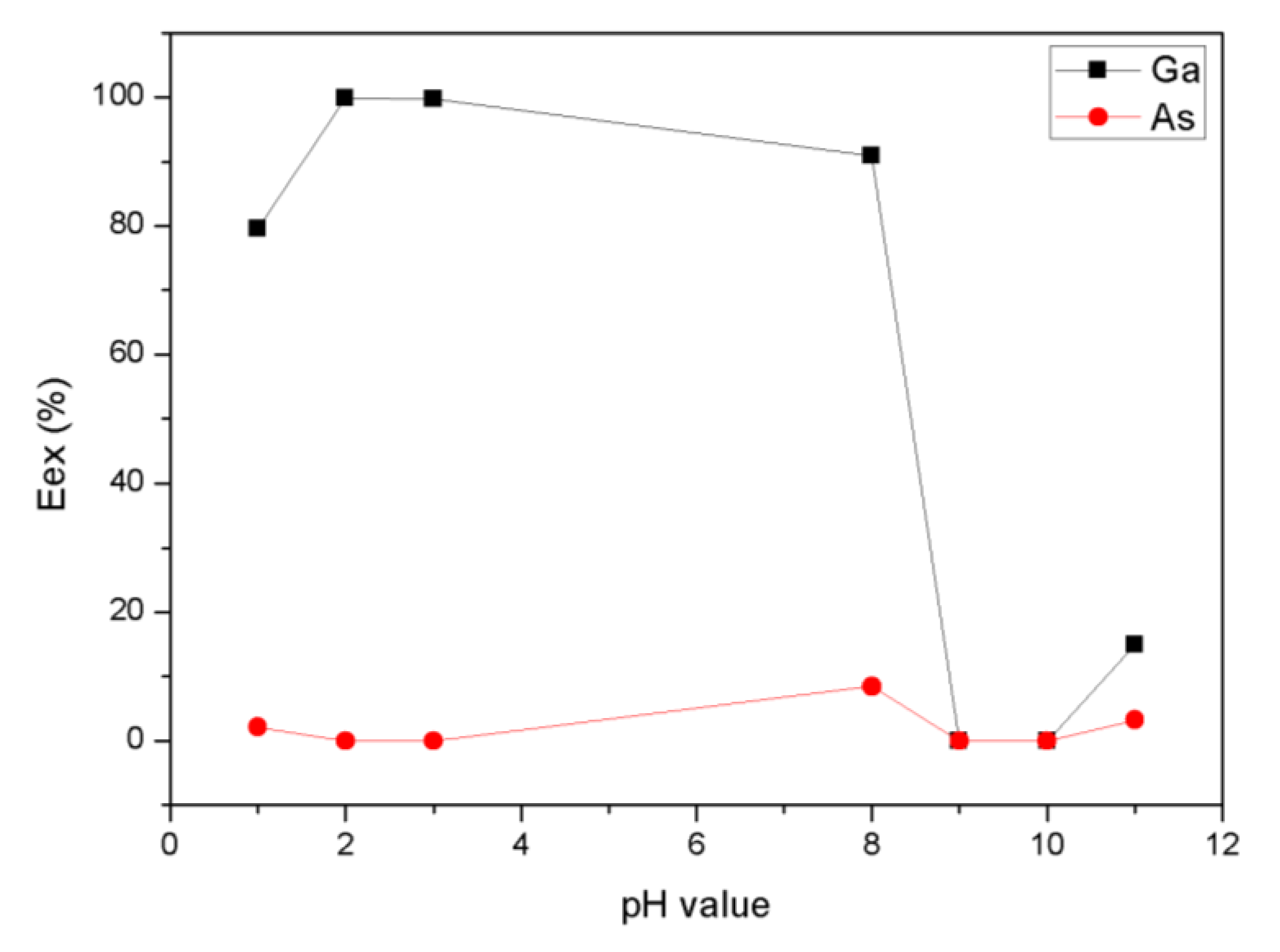
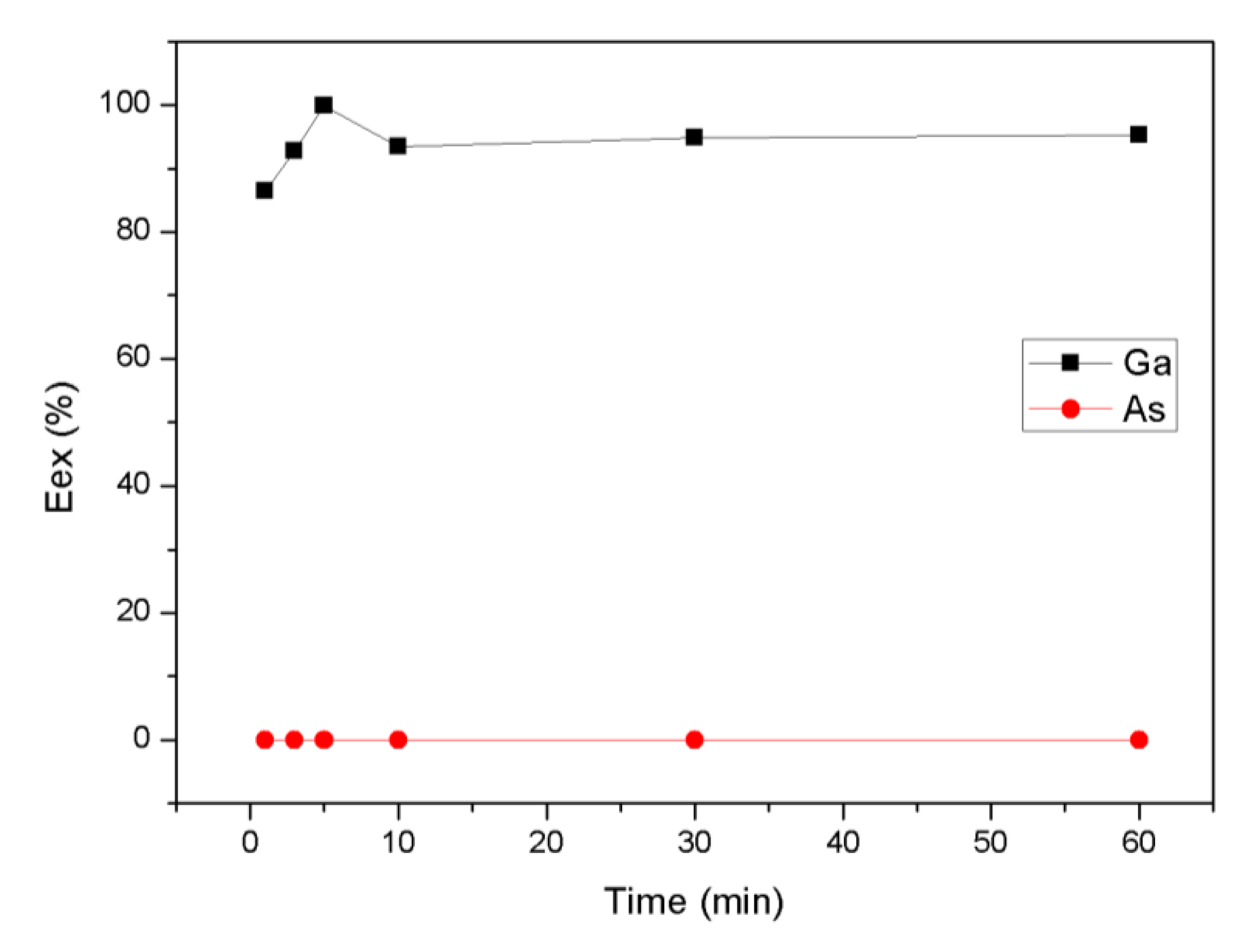
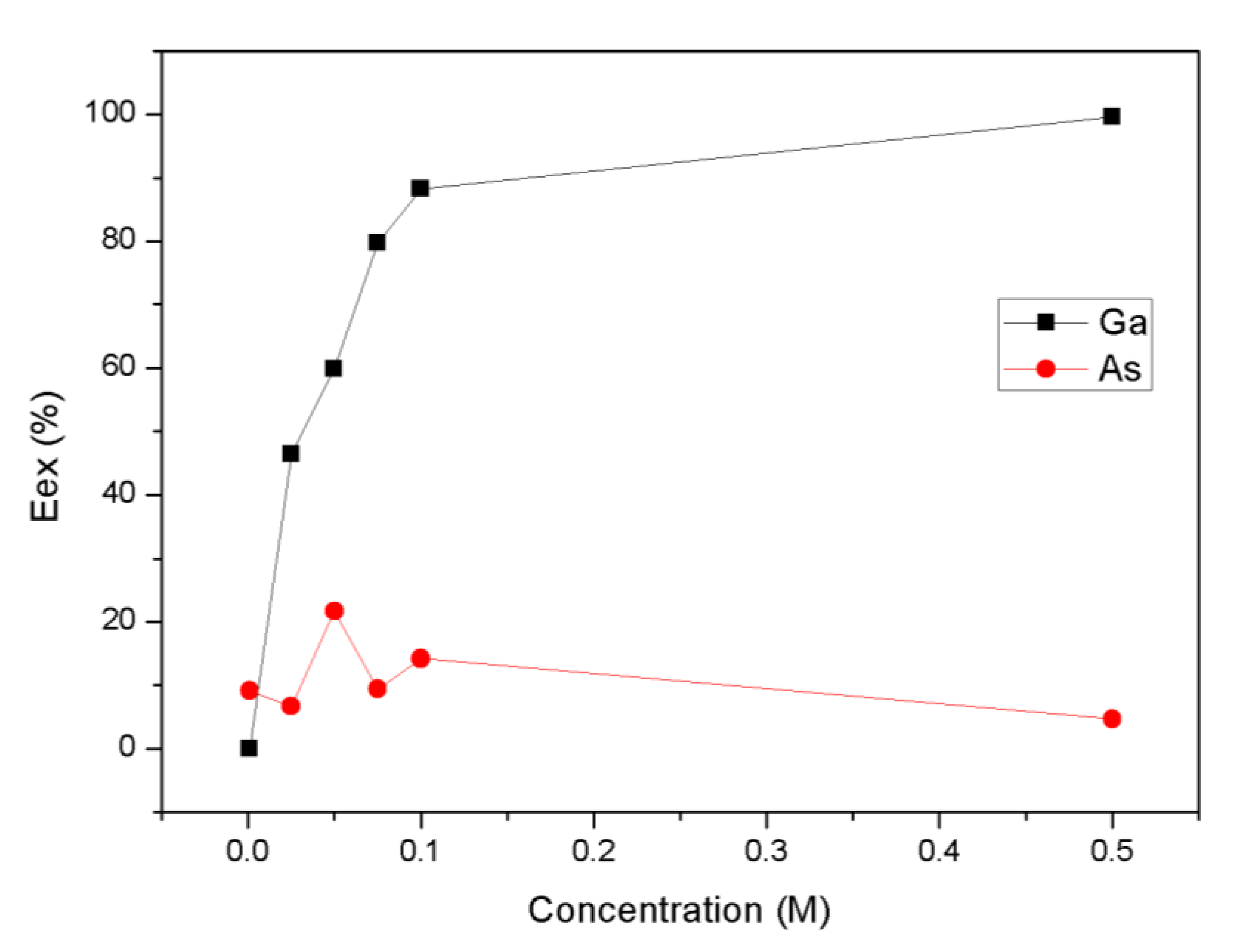
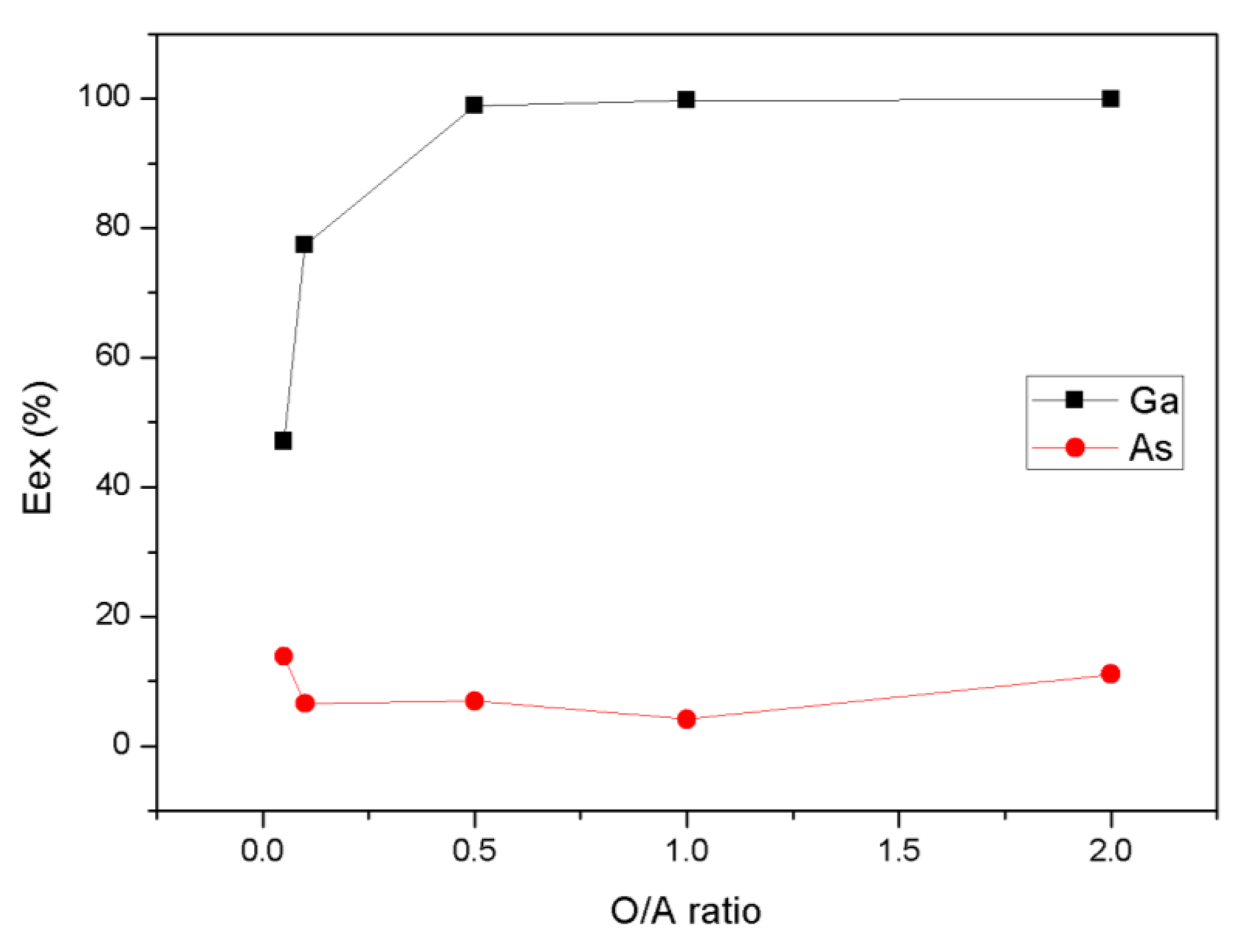
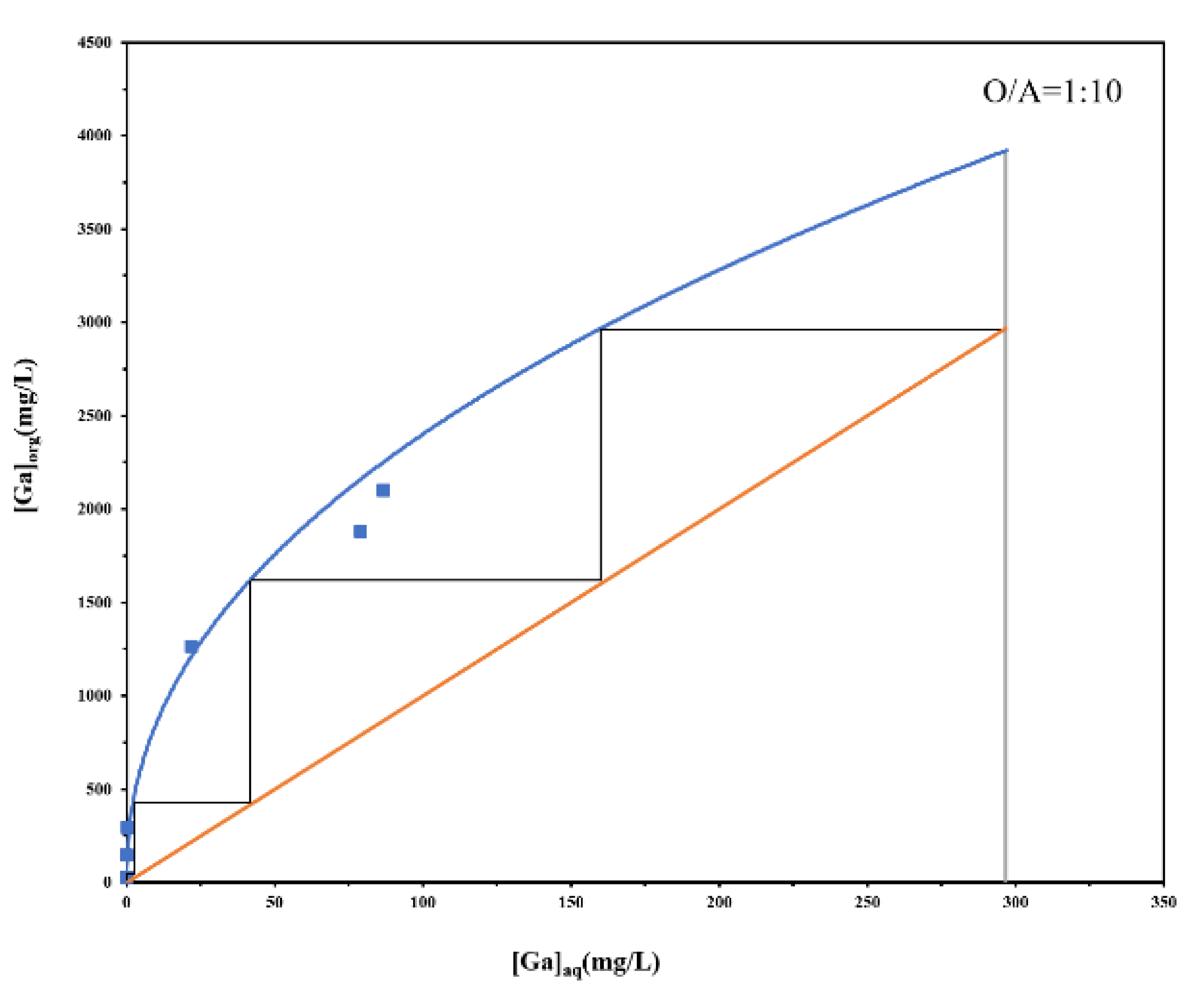
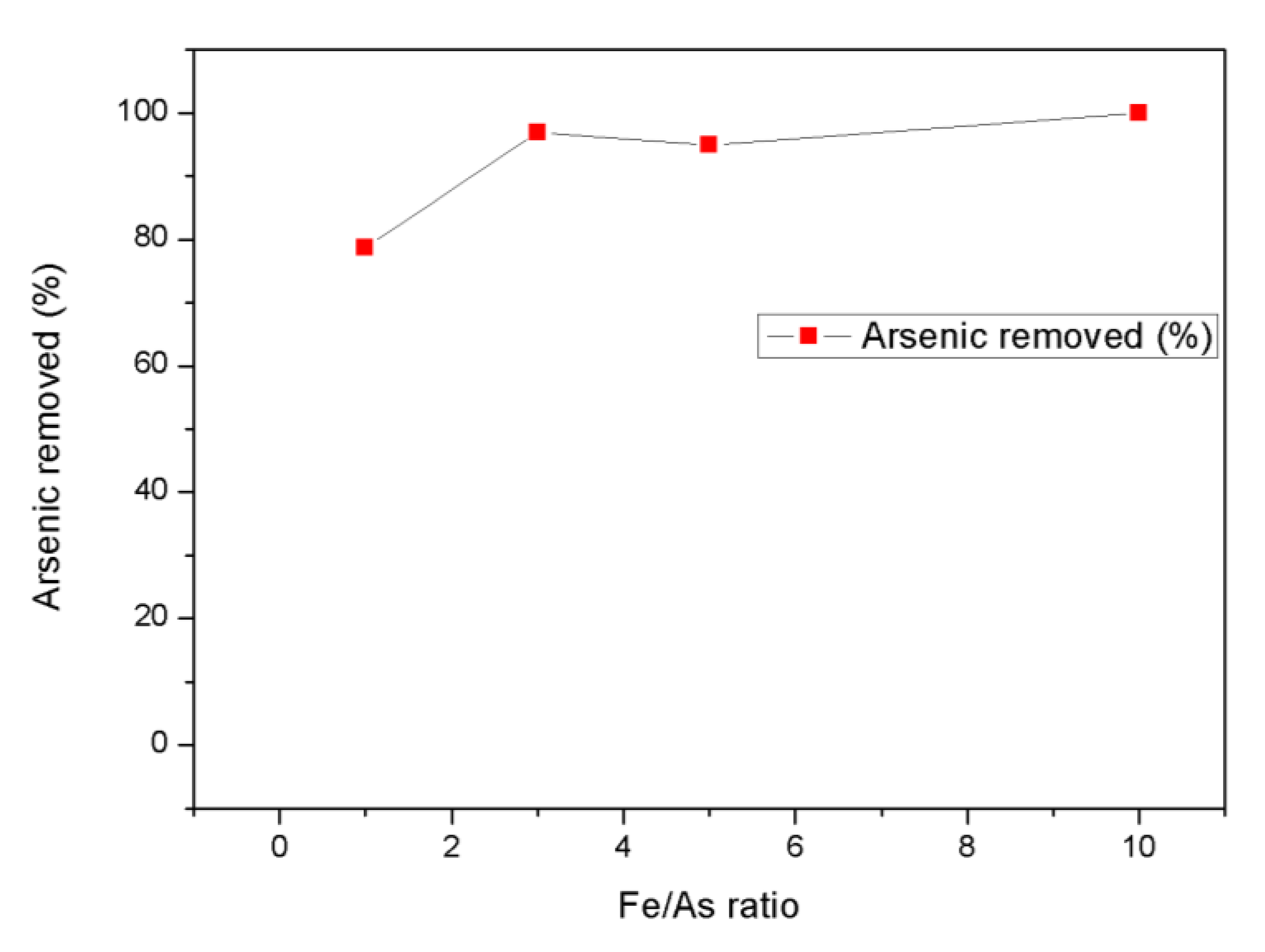
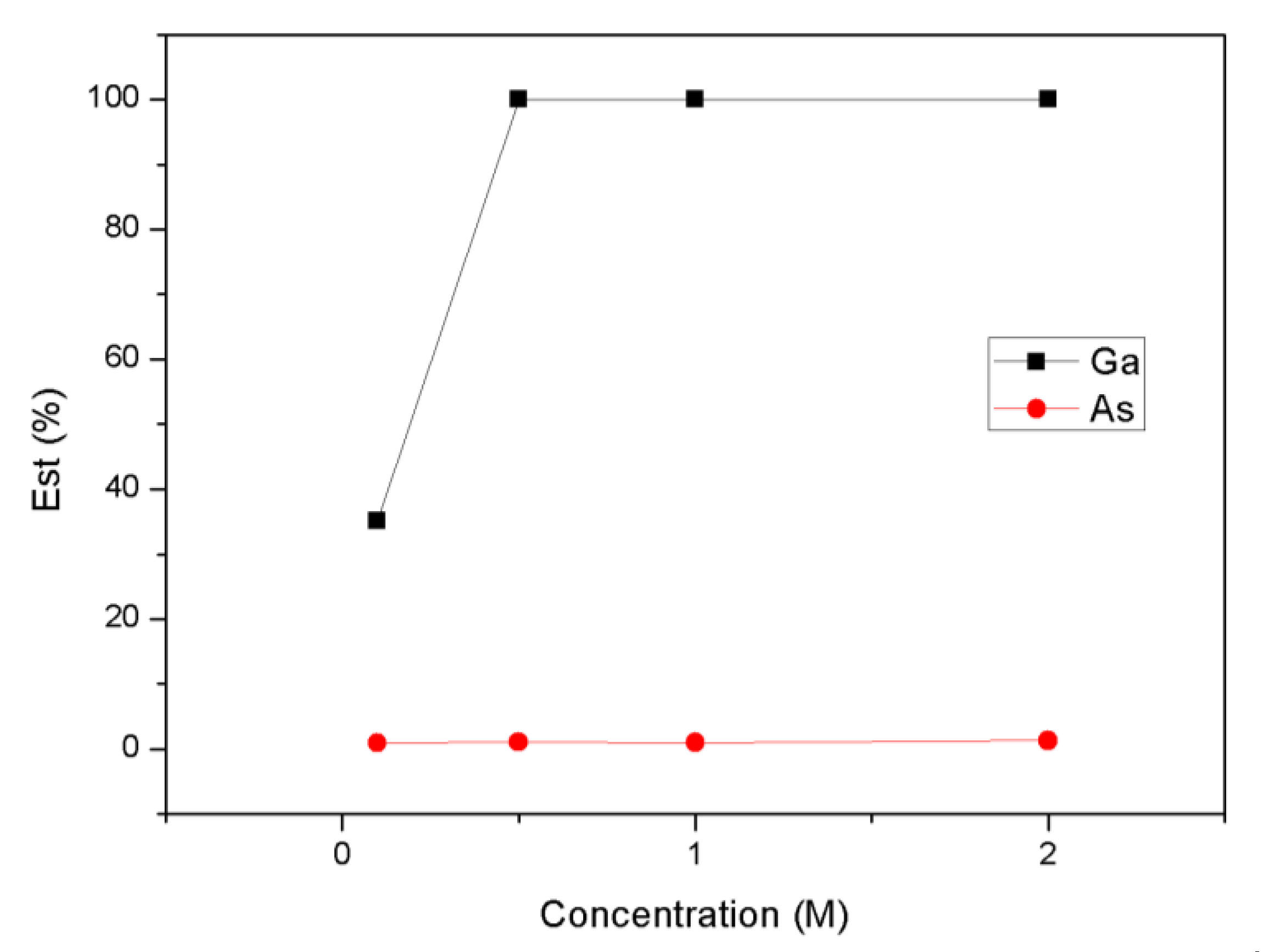
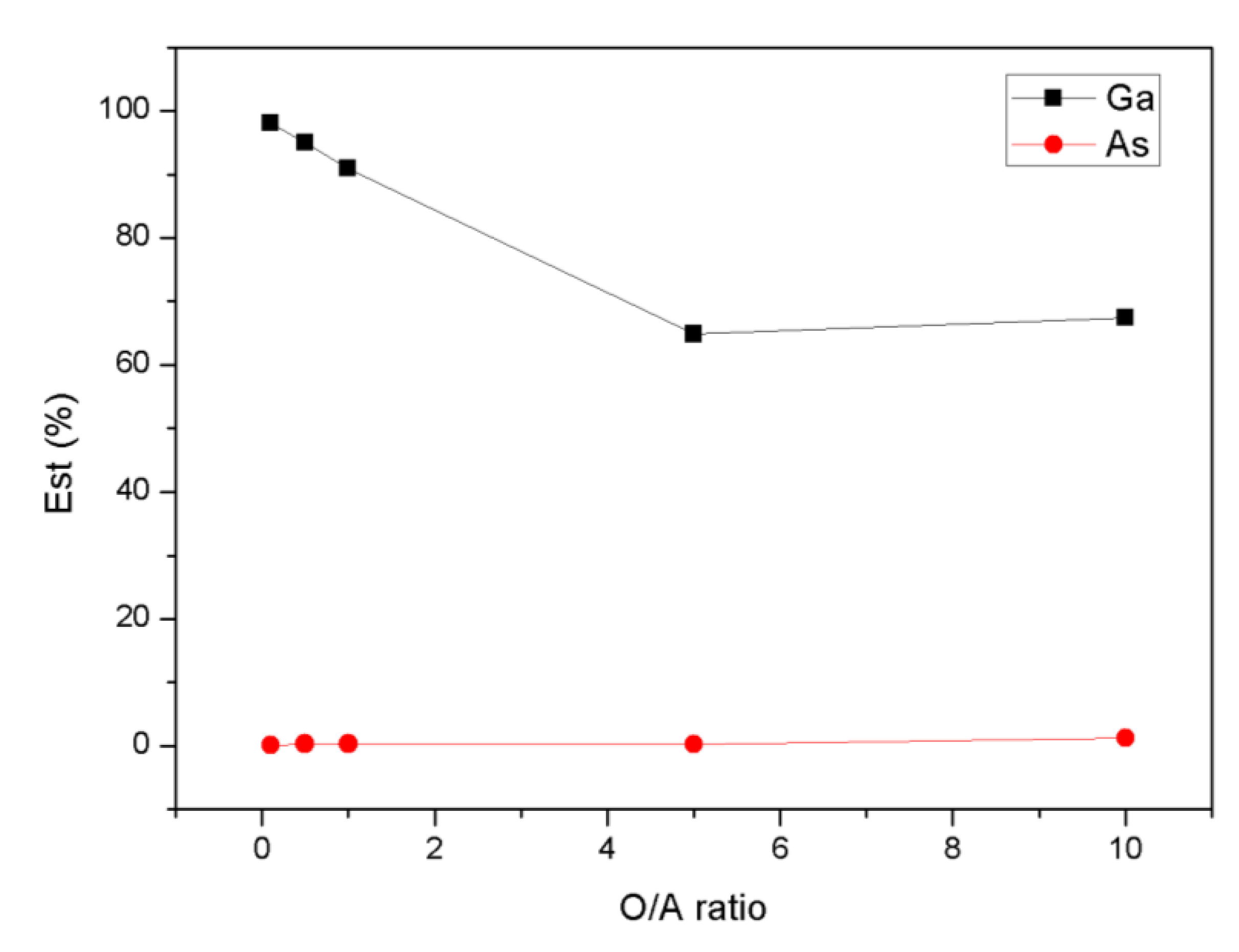
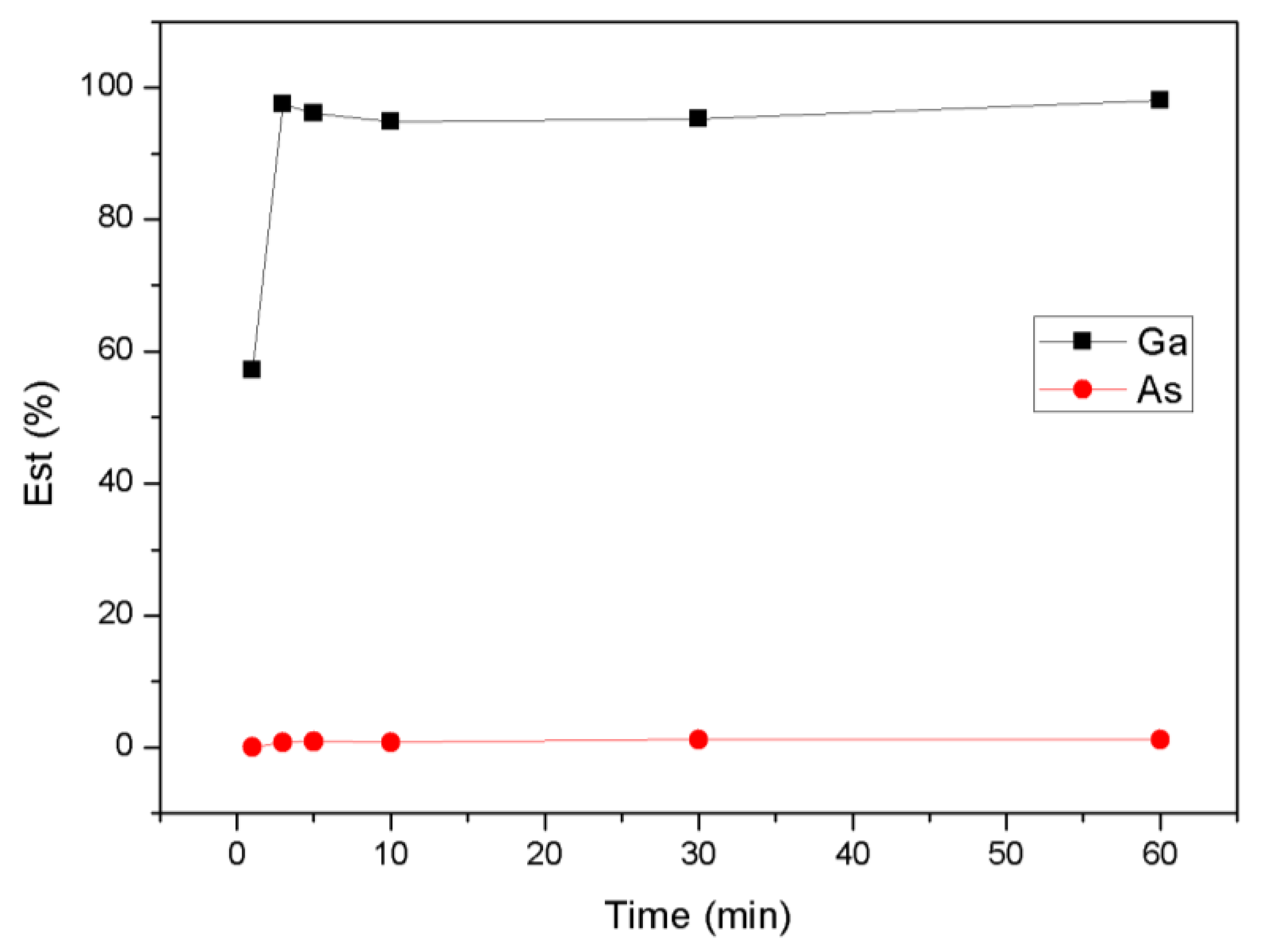
| Element | Ion Concentration (ppm) |
|---|---|
| Ga | 244.9 ppm |
| As | 108.5 ppm |
| O/A Ratio | Eex (%) | Ratio of Concentration (%) |
|---|---|---|
| 2 | Ga: 99.9% | Ga: 49.9% |
| As: 11.1% | As: 5.6% | |
| 1 | Ga: 99.7% | Ga: 99.7% |
| As: 4.1% | As: 4.1% | |
| 0.5 | Ga: 98.9% | Ga: 197.8% |
| As: 6.9% | As: 13.8% | |
| 0.1 | Ga: 77.4% | Ga: 774.2% |
| As: 6.6% | As: 65.6% | |
| 0.05 | Ga: 47.1% | Ga: 1225.9% |
| As: 13.8% | As: 276.5% |
© 2020 by the authors. Licensee MDPI, Basel, Switzerland. This article is an open access article distributed under the terms and conditions of the Creative Commons Attribution (CC BY) license (http://creativecommons.org/licenses/by/4.0/).
Share and Cite
Chen, W.-S.; Tien, K.-W.; Wang, L.-P.; Lee, C.-H.; Chung, Y.-F. Recovery of Gallium from Simulated GaAs Waste Etching Solutions by Solvent Extraction. Sustainability 2020, 12, 1765. https://doi.org/10.3390/su12051765
Chen W-S, Tien K-W, Wang L-P, Lee C-H, Chung Y-F. Recovery of Gallium from Simulated GaAs Waste Etching Solutions by Solvent Extraction. Sustainability. 2020; 12(5):1765. https://doi.org/10.3390/su12051765
Chicago/Turabian StyleChen, Wei-Sheng, Ko-Wei Tien, Li-Pang Wang, Cheng-Han Lee, and Yi-Fan Chung. 2020. "Recovery of Gallium from Simulated GaAs Waste Etching Solutions by Solvent Extraction" Sustainability 12, no. 5: 1765. https://doi.org/10.3390/su12051765
APA StyleChen, W.-S., Tien, K.-W., Wang, L.-P., Lee, C.-H., & Chung, Y.-F. (2020). Recovery of Gallium from Simulated GaAs Waste Etching Solutions by Solvent Extraction. Sustainability, 12(5), 1765. https://doi.org/10.3390/su12051765








